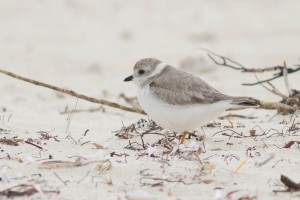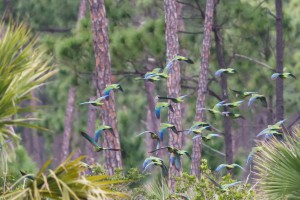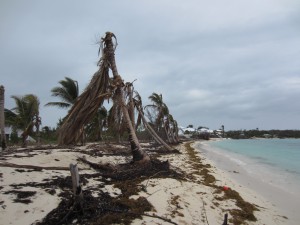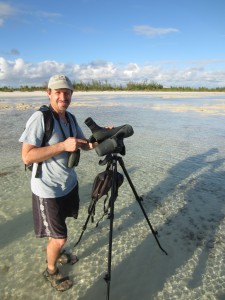Plovers and Parrots in Paradise
A RETURN TRIP TO THE BAHAMAS
By Todd Pover, Beach Nesting Bird Project Manager

Last month marked the third January I have been able to go to the Bahamas in the name of piping plover research. This recent trip was a little different than the others in that it was not an official work funded trip. Still, it wasn’t a traditional vacation either as a good portion of the trip was dedicated to plover surveys and related work. (It’s hard keeping me away from those pipers!)
This being on my own dime, I did make it a point to sample some of the Bahamas other wildlife this time around. At the top of my list was the Bahama parrot. Once found on many Bahamas islands, the parrot is now only present on Abaco and Great Inagua, and is a protected species in the Bahamas. Abaco National Park, overseen by the Bahamas National Trust, encompasses over 20,000 acres, including some of the most critical parrot habitat. Ongoing research of the parrot’s breeding success is being conducted on Abaco as well – it is heartening to see significant conservation effort being put towards parrots in the Bahamas.

I had heard the calls of parrots on previous trips, but since I literally had my “head in the sand” looking for plovers I hadn’t actually seen them. For awhile I didn’t think I would get a glimpse of them this time either – although we were at a parrot hotspot in Abaco known as Bahama Palm Shores, once again I heard them but couldn’t quite get them in my sights. Parrots can be quite social and their chatter was clearly audible in the trees around us – tantalizingly close – but surprisingly hard to see for a large colorful bird. Our patience paid off as suddenly a flock of at least 100 parrots lifted up and circled over us, temporarily blackening the sky (perhaps “brightening the sky” is more appropriate in this case). What a spectacular sight and later we would see a smaller flock close up foraging in a field.
One of the most interesting things about the parrots on Abaco is that they are ground nesters – just like our beach nesting birds – instead of the sand on the beach they nest in limestone cavities on the pinewood forest floor. And like our beachnesters, nesting on the ground makes them and their nests vulnerable to mammalian predators. Cats, in particular, have been a serious threat to the survival and breeding success of the parrots. Given the obvious differences between the appearance and habitats of Abaco’s parrots and piping plovers, what a surprise it was to find a behavioral and conservation link between these two at-risk species!

Another notable topical link between Abaco and New Jersey is that both were impacted by Hurricane Sandy – before she rolled ashore in New Jersey, Sandy violently swept through the Bahamas. The impact of Sandy was observed at several locations on this trip; topped palm trees and erosion on Green Turtle Cay and sand being moved to shore up battered homes and beaches on Elbow Cay. Piping plovers missed being directly impacted by Sandy in New Jersey because they had already migrated south, but that doesn’t mean our breeders weren’t impacted somewhere else on their wintering grounds, such as the Bahamas.
This brings me back to the specific connection between piping plovers and the Bahamas. Recent surveys and banding studies have now clearly identified the Bahamas as the most important wintering site for our Atlantic Coast population of piping plovers. If all our hard work here on the breeding grounds is going to succeed, we need to ensure they are also protected on the wintering grounds, where they spend at least as much of, if not more of their time. Recovery and long-term survival of piping plovers (and any long-distance migratory shorebird) is going to depend on “full life cycle” conservation.
To date, relatively limited attention has been focused on studying and protecting piping plovers on their migratory and wintering grounds. That is changing and in fact the U.S. Fish and Wildlife Service have just unveiled a Comprehensive Conservation Strategy for piping plovers in their non-breeding range that should jumpstart additional conservation efforts.

Towards that end, my recent trip included piping plover surveys on both Grand Bahama and Abaco. The Grand Bahama segment included resighting of banded plovers, as well as trying to confirm the importance of several sites for wintering shorebirds, in particular the Pelican Point area on the island’s east end. Surveys on Abaco included those at Green Turtle Cay, long known as a regular wintering site for piping plovers, but recent surveys we have conducted at varying tide stages show it is equally important as both a foraging and roosting location. Likewise, surveys we completed in the Cherokee Sound/Casuarina Point complex show that plover usage at specific sites in this area is highly dependent on tide, not surprising, but critical information for any future conservation or comprehensive survey effort.
Next month, CWFNJ will submit a grant to the Disney Worldwide Conservation Fund to continue our piping plover work in the Bahamas. We hope to partner directly with Friends of the Environment, a local conservation group on Abaco we have previously worked with, to raise awareness of the importance of the Bahamas to piping plovers and to conduct further research on their local distribution and use of habitat on their winter grounds.

Note: A special thanks to the Bahamas National Trust for generously housing us at their Rand Nature Center during our stay on Grand Bahama and to Predensa “Denny” Moore for her ongoing support for piping plover conservation in the Bahamas. Also, a shout out to my colleagues and the rest of the New Jersey Piping Plover Team on this Bahamas trip; Christina “Kashi” Davis, Emily “Em” Heiser, and Tom “TR” Reed. And it appears I have a new nickname – “Tplove” – courtesy of the team, but we shall see if it sticks.
Discover more from Conserve Wildlife Foundation of NJ
Subscribe to get the latest posts sent to your email.